
WHAIORO TRUST
Whakapapa / History
In 1998 the Health Funding Authority (at the time) approached Dennis Emery - CEO for Te Runanga o Raukawa and Brad Grimmer – CEO for Mash Trust in Palmerston North regarding a joint venture between two health providers aimed to provide supported accommodation, employment and training opportunities for mental health clients.
Te Runanga O Raukawa was a large Iwi health provider of mental health support service in the Ngati Raukawa tribal area, from Bulls in the north to Te Horo in the south of the lower North Island.
MASH Trust – was a major provider of accommodation and support programmes for mental health clients in Palmerston North and had recently expanded their operations to Wellington.
This joint venture was an opportunity for two established organisations to work collaboratively together and was a trend setter in this type of health service delivery in the country at the time.
-
Ko te ingoa – Name
Whaioro conceptually means “Two different organisations coming together and assisting tāngata turoro on their journey to wellness”. A Kuia no Ngati Kauwhata me Ngati Haua-ki-Waikato, Moahuia Emery was approached. The name she gave was “Whaioro” which she explained came from Tainui. She went on further to say that the Tainui people use the word “turoro” to describe a patient or a client and “whaioro” – in pursuit of wellness and health.
The description she gave on the day was literally…“Two different organisations coming together and assisting tāngata turoro on their journey to wellness”. This whakaaro (explanation/rationale) is what later informed the Moemoea / vision for Whaioro Trust, the whakaaro for both the Logo and the Whaioro Model. During the course of the negotiations to establish a joint venture and Trust, the CEO of Te Runanga O Raukawa was asked to provide a suitable Māori name by which the services would be established and operate.
-
Whaioro – Tainui Waka meaning
A Kuia no Ngati Kauwhata me Ngati Haua-ki-Waikato, Moahuia Emery was approached. The name she gave was “Whaioro” which she explained came from Tainui. She went on further to say that the Tainui people use the word “turoro” to describe a patient or a client and “whaioro” – in pursuit of wellness and health.
The description she gave on the day was literally…“Two different organisations coming together and assisting tangata turoro on their journey to wellness”. This whakaaro (explanation/rationale) is what later informed the Moemoea / vision for Whaioro Trust, the whakaaro for both the Logo and the Whaioro Model.
-
Joint Venture
The partnership between Te Runanga O Raukawa and MASH Trust provided a bi-cultural milieu that enabled Whaioro Trust to develop into the organisation represented today.
-
Rohe Covered
The rohe (area) covered by Whaioro Trust is the wider Manawatū and Horowhenua regions, under the mantle of Ngati Raukawa, who represent 24 hapu of Ngati Raukawa between the tribal boundaries mai Waitapu ki Miria Te Kakara, Miria Te Kakara ki Kukutauaki (from Bulls in the north to Te Horo in the south of the lower North Island).
-
Governance
Whaioro Trust became a registered legal entity under the Charitable Trusts Act, 1957 in 1999. The make up of the Board of Trustees comprised of four representatives from Te Runanga O Raukawa Inc and four representatives from MASH Trust.
-
The Original Trustees of Whaioro Trust
As at the 8th of August 1999 were:
(Te Runanga O Raukawa)
- Margaret Te Ruihi Walsh,
- Rei Mereana Rawlinson,
- Hare Rewiti Arapere
(MASH Trust)
- Allanah Joan Chettleburgh
- Shelley Dew-Hopkins
- Catherine Heather Allan
Logo
The Whaioro logo is representative of two organisations coming together and characterized in the combination of the Te Rūnanga o Raukawa and MASH logos



All Rights Reserved | Whaioro Trust